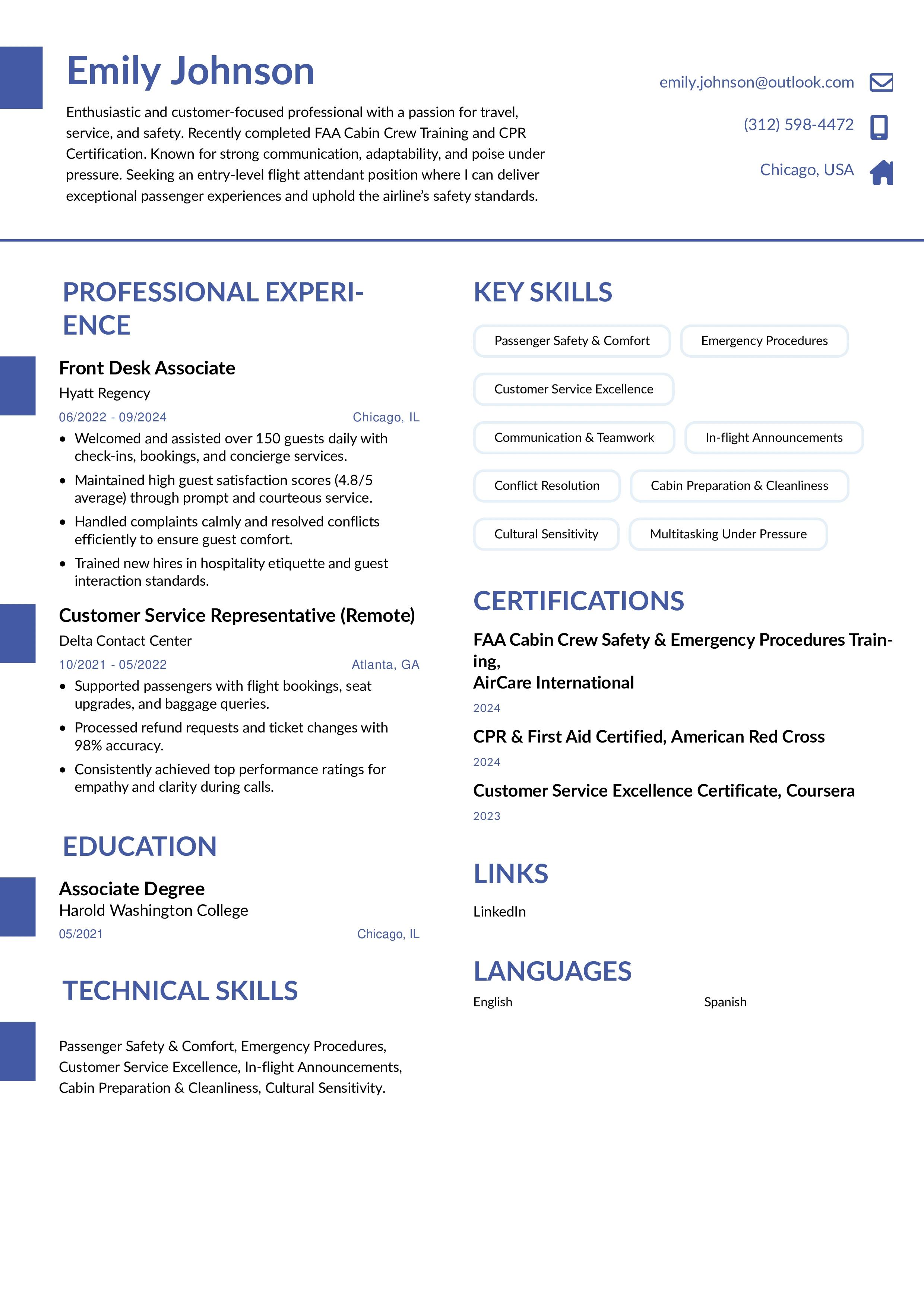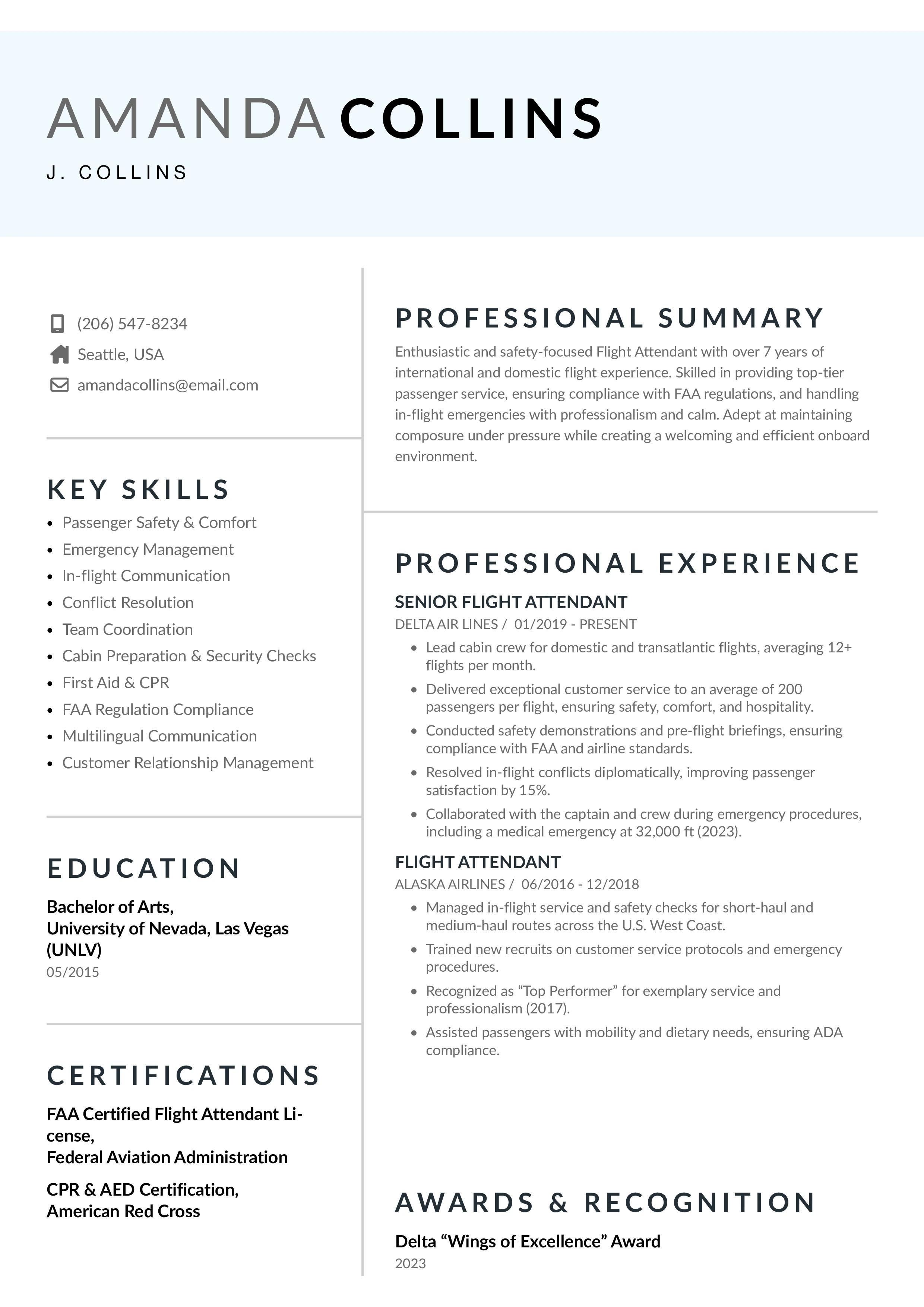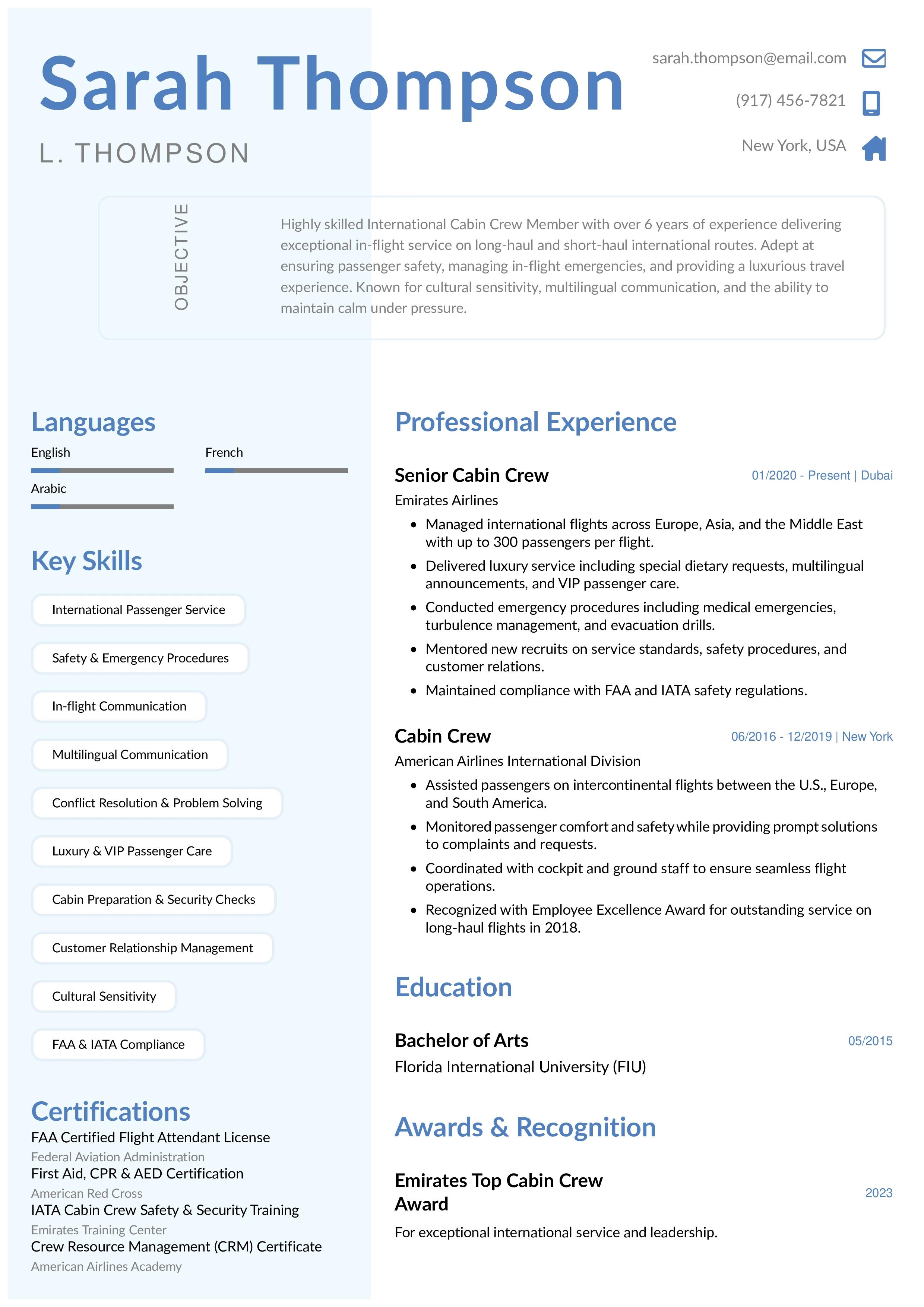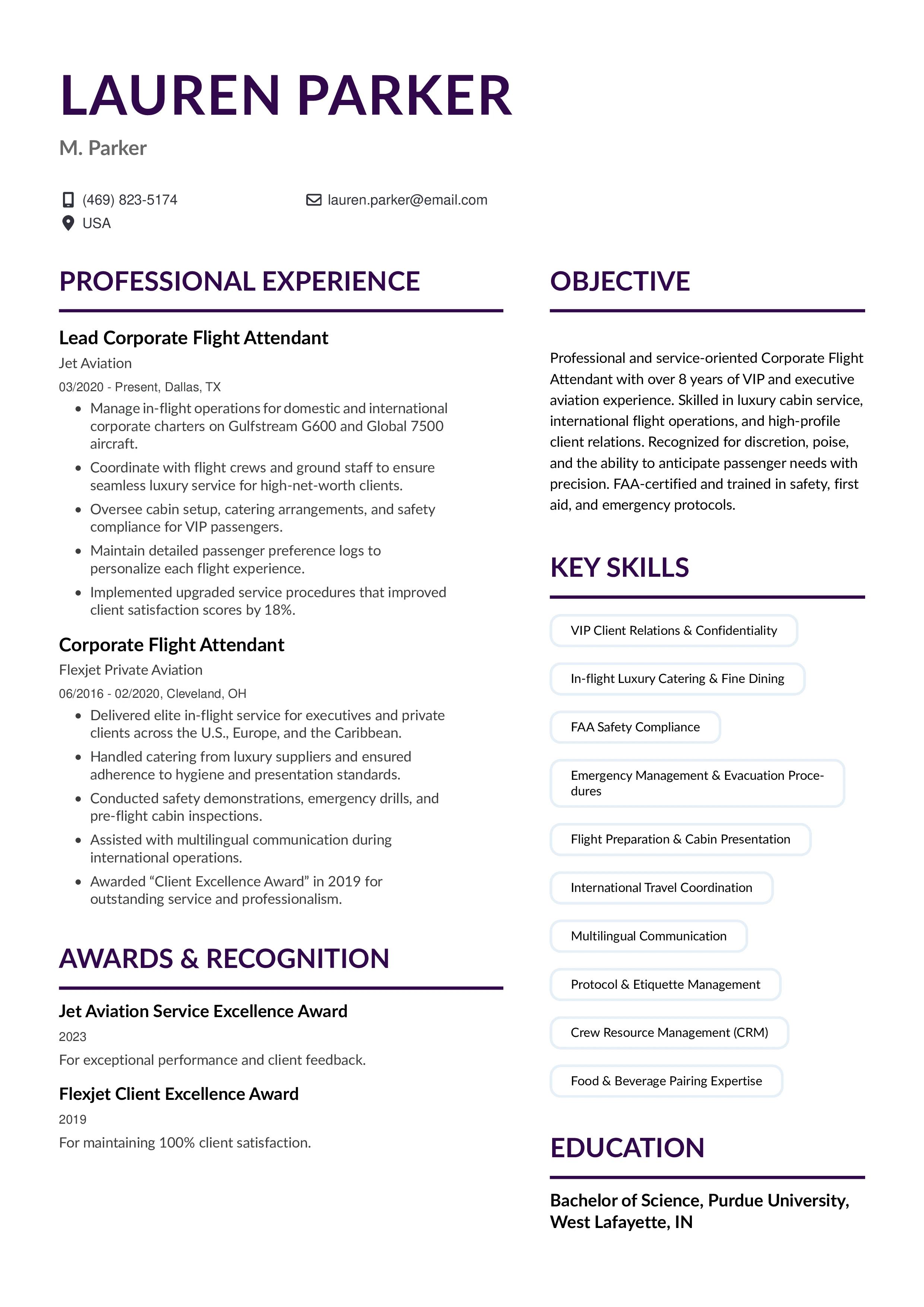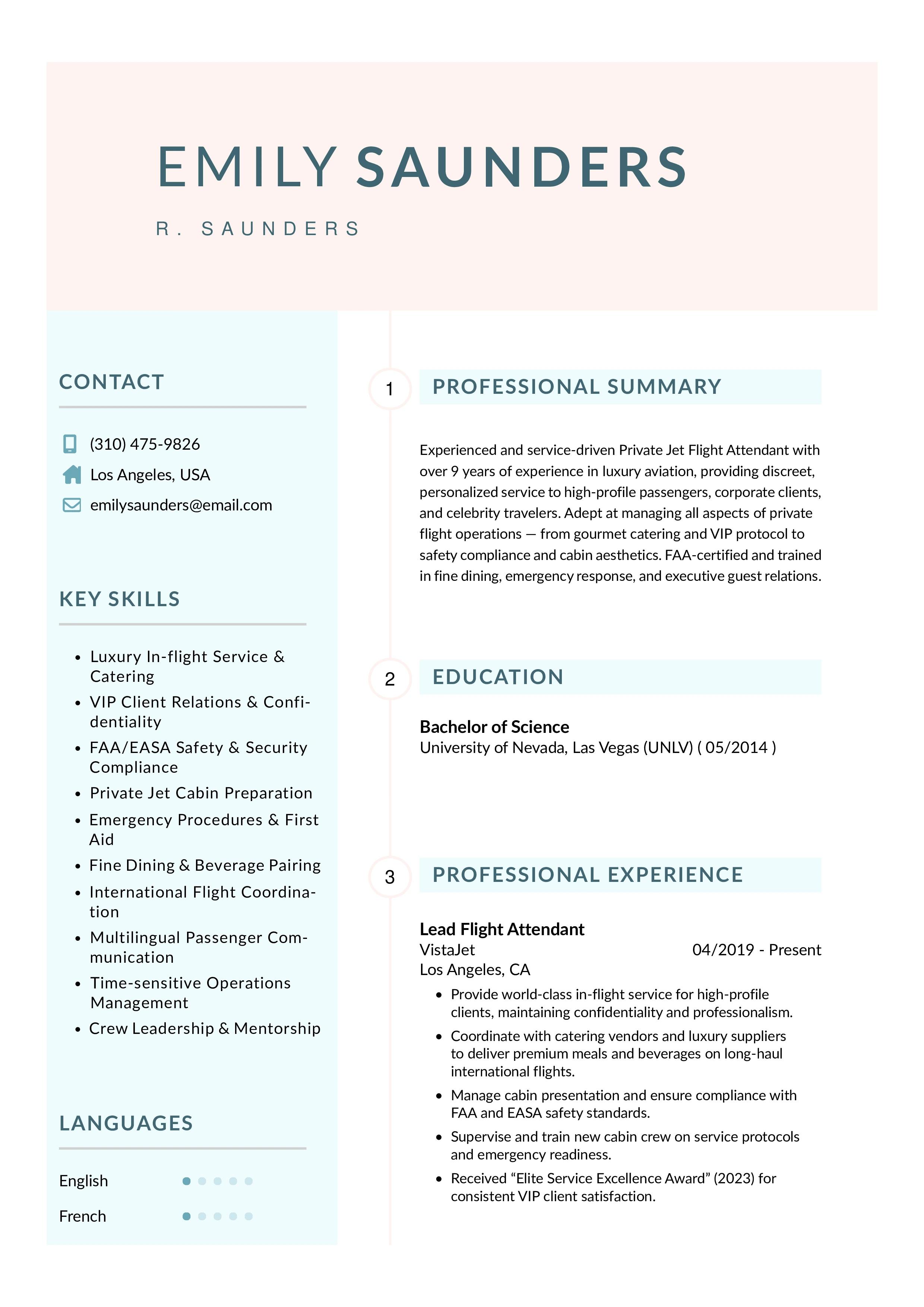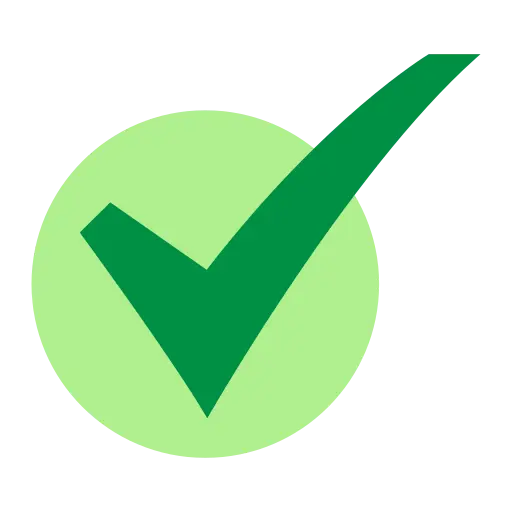Flight Attendant Resume Example & Writing Guide (2025)
Trust Score: 4.8
356 reviews
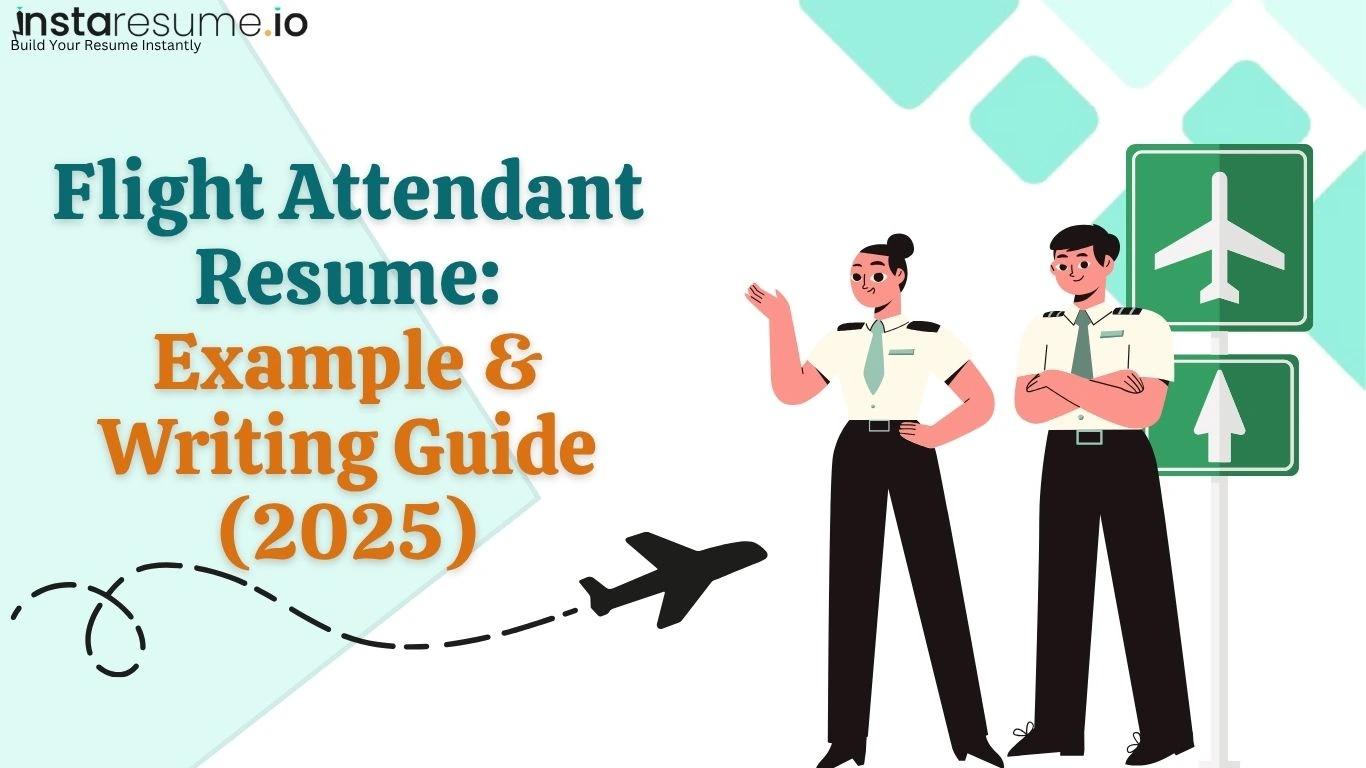
Table of Contents
What Is a Flight Attendant Resume?
A Flight Attendant Resume (also called a Cabin Crew Resume or Air Hostess Resume) is a professional document that highlights your qualifications, experience, and interpersonal skills required to work in the aviation industry. It serves as your first impression to airline recruiters—showcasing that you not only meet the technical requirements of the job but also reflect the charm, professionalism, and safety awareness airlines expect from their crew members.
In today’s competitive airline job market, a well-structured flight attendant resume is essential for passing Applicant Tracking Systems (ATS) and capturing the attention of hiring managers at top airlines like Emirates, Delta, or IndiGo. Your resume should demonstrate your customer service excellence, communication proficiency, and attention to safety protocols—the three pillars of an outstanding cabin crew member.
Most airlines evaluate candidates based on key traits such as:
 Professional appearance and grooming standards that align with brand expectations.
Professional appearance and grooming standards that align with brand expectations. Fluent communication skills to interact effectively with passengers from diverse backgrounds.
Fluent communication skills to interact effectively with passengers from diverse backgrounds. Emergency and safety awareness, ensuring passengers’ well-being during flights.
Emergency and safety awareness, ensuring passengers’ well-being during flights. Customer service orientation, showing empathy, patience, and cultural sensitivity.
Customer service orientation, showing empathy, patience, and cultural sensitivity.
A powerful Flight Attendant Resume does more than list your duties—it tells a story of your reliability, calm under pressure, and passion for creating memorable travel experiences. Whether you’re an experienced cabin crew member or a first-time applicant, your resume should reflect the unique combination of professionalism and hospitality that airlines value most.
Why Your Flight Attendant Resume Matters
In the aviation industry, your Flight Attendant Resume is more than a document — it’s your boarding pass to a professional airline career. Airlines receive thousands of applications each month, and recruiters have just seconds to decide whether a candidate fits their brand image and service expectations. That’s why understanding the importance of a flight attendant resume is the first step toward landing your dream airline job.
A professional airline resume is carefully designed to reflect not only your qualifications but also your personality, presentation, and communication style. Recruiters are trained to spot candidates who radiate confidence, empathy, and discipline — traits essential for maintaining in-flight harmony and ensuring passenger safety.
When screening resumes, hiring teams often look for:
 Polished presentation and formatting: A neat, well-structured resume mirrors your attention to detail and grooming standards.
Polished presentation and formatting: A neat, well-structured resume mirrors your attention to detail and grooming standards. Positive personality traits: Airlines prefer candidates who exhibit warmth, patience, and adaptability — especially under pressure.
Positive personality traits: Airlines prefer candidates who exhibit warmth, patience, and adaptability — especially under pressure. Excellent communication skills: Fluency and clarity in English (and other languages) are vital for international carriers.
Excellent communication skills: Fluency and clarity in English (and other languages) are vital for international carriers.
Every airline has its unique culture and service philosophy. For instance:
 Emirates focuses on luxury hospitality and global elegance.
Emirates focuses on luxury hospitality and global elegance. Delta Airlines emphasizes customer satisfaction and safety compliance.
Delta Airlines emphasizes customer satisfaction and safety compliance. Qatar Airways values multicultural communication and premium service.
Qatar Airways values multicultural communication and premium service. IndiGo prioritizes punctuality, teamwork, and cheerful professionalism.
IndiGo prioritizes punctuality, teamwork, and cheerful professionalism.
That’s why tailoring your resume for each airline is essential. A one-size-fits-all approach rarely works — recruiters can instantly tell when a resume isn’t personalized. By aligning your flight attendant resume with the airline’s brand tone, job description, and values, you dramatically increase your chances of being shortlisted for interviews.
Ultimately, a great resume doesn’t just list duties — it conveys who you are, how you serve, and how you embody the airline’s promise of exceptional passenger experience.
Types of Flight Attendant Resume (+7 Real Job-Based Examples)
Every airline and aviation role demands a unique skill set and presentation style. Whether you’re new to the skies or a seasoned professional, choosing the right Flight Attendant Resume format can make your profile stand out. Below are seven high-performing flight attendant resume examples, each tailored for specific job types and optimized with key industry phrases that recruiters actually search for.
Entry-Level Flight Attendant Resume (No Experience)
Why This Entry-Level Flight Attendant Resume Example Is Perfect for Editing
Creating a standout flight attendant resume can be challenging, especially if you have little to no professional experience. This entry-level flight attendant resume example is ideal for editing because it provides a ready-made, structured foundation that balances ATS optimization, professional formatting, and real-life relevancy. Here’s why it works perfectly:
1. ATS-Friendly Structure
 Clearly divided sections: Professional Summary, Experience, Education, Skills, Certifications.
Clearly divided sections: Professional Summary, Experience, Education, Skills, Certifications. Strategic placement of keywords such as Passenger Safety, Emergency Procedures, Customer Service, which match common flight attendant job descriptions.
Strategic placement of keywords such as Passenger Safety, Emergency Procedures, Customer Service, which match common flight attendant job descriptions. Easy-to-read formatting ensures your resume passes Applicant Tracking Systems used by airlines.
Easy-to-read formatting ensures your resume passes Applicant Tracking Systems used by airlines.
2. Emphasizes Transferable Skills
 Highlights customer service experience from hospitality and call center roles.
Highlights customer service experience from hospitality and call center roles. Showcases communication, conflict resolution, and multitasking—essential skills for flight attendants.
Showcases communication, conflict resolution, and multitasking—essential skills for flight attendants. Demonstrates readiness to handle real-life situations despite lacking direct in-flight experience.
Demonstrates readiness to handle real-life situations despite lacking direct in-flight experience.
3. Incorporates Relevant Certifications
 Includes FAA Cabin Crew Training and CPR certification to show preparedness for safety and emergency protocols.
Includes FAA Cabin Crew Training and CPR certification to show preparedness for safety and emergency protocols. Certifications act as credibility boosters, making recruiters confident in your potential.
Certifications act as credibility boosters, making recruiters confident in your potential.
4. Customizable for Any Airline
 Uses generic but realistic details (U.S. location, LinkedIn profile, valid passport) that can be tailored to any airline.
Uses generic but realistic details (U.S. location, LinkedIn profile, valid passport) that can be tailored to any airline. Job titles and experience are flexible, allowing candidates to replace them with internships, volunteer work, or other service-related roles.
Job titles and experience are flexible, allowing candidates to replace them with internships, volunteer work, or other service-related roles.
5. Professional Summary That Pops
 Starts with enthusiasm and customer-focus, grabbing recruiters’ attention.
Starts with enthusiasm and customer-focus, grabbing recruiters’ attention. Includes clear objectives and personality traits relevant to the airline industry, such as adaptability, poise, and professionalism.
Includes clear objectives and personality traits relevant to the airline industry, such as adaptability, poise, and professionalism.
6. Balance Between Realism and Professionalism
 Realistic U.S.-based experience makes the resume credible for actual applications.
Realistic U.S.-based experience makes the resume credible for actual applications. Avoids fluff while still demonstrating initiative, readiness, and potential.
Avoids fluff while still demonstrating initiative, readiness, and potential.
Bottom line: This resume example gives you a strong foundation that’s easy to edit, ATS-ready, and perfectly tailored for aspiring flight attendants aiming to make a professional impression.
Experienced Flight Attendant Resume Example
Why This Experienced Flight Attendant Resume Example Is Perfect for Editing
Creating a professional Flight Attendant resume can feel overwhelming, especially when you want to stand out in a competitive airline industry. This experienced flight attendant resume example is designed to make that process seamless. Here’s why it’s perfect for editing and customizing for your career goals:
1. ATS-Friendly Structure
The resume uses a clean, well-organized format that passes Applicant Tracking Systems (ATS), ensuring your application reaches human recruiters without being filtered out.
2. Professional Summary You Can Tailor
The sample includes a strong professional summary highlighting safety expertise, customer service skills, and international flight experience — all of which you can easily adjust to match your personal achievements.
3. Quantifiable Achievements
It incorporates measurable accomplishments, such as passenger satisfaction scores and emergency management instances, helping your resume stand out with real-world impact.
4. Comprehensive Skills Section
The skills are clearly categorized, covering both hard skills (FAA compliance, first aid) and soft skills (communication, conflict resolution). You can edit this section to reflect your unique strengths.
International Cabin Crew Resume Example
Why This International Cabin Crew Member Resume Example Is Perfect for Editing
Creating a professional International Cabin Crew resume can be challenging, especially when applying to top airlines. This international cabin crew member resume example is crafted to make your job search easier and ensure your application stands out. Here’s why it’s perfect for editing and tailoring:
1. ATS-Friendly Layout
The resume is designed to pass Applicant Tracking Systems (ATS), making sure your application reaches recruiters without being filtered out. Each section is clearly defined and keyword-optimized for airline recruitment.
2. Customizable Professional Summary
The professional summary highlights international experience, safety expertise, and multilingual communication. You can easily adjust it to emphasize your unique skills, routes, or airline experience.
3. Quantifiable Achievements
Including measurable accomplishments, such as passenger satisfaction scores, awards, or emergency management, helps your resume demonstrate real-world impact. These metrics can be updated to match your personal record.
4. Comprehensive Skills Section
The example features a balanced mix of hard skills (FAA/IATA compliance, first aid) and soft skills (conflict resolution, cultural sensitivity). You can edit this section to showcase the exact strengths that make you an ideal cabin crew member.
5. Realistic Work Experience
The resume provides detailed, realistic examples of international flight duties and responsibilities, which you can easily replace with your own airline history, flight routes, and achievements.
6. Certifications & Education
It includes essential qualifications like FAA Certification, First Aid, CPR & AED, and IATA safety training. You can update this section with your own certifications to align with your experience.
7. Easy to Edit & Tailor
Every part of this resume — from header to awards — is structured for easy editing, allowing you to create a customized, professional international cabin crew resume that grabs recruiter attention.
Pro Tip: Always personalize metrics, awards, and responsibilities to reflect your actual accomplishments for maximum impact.
Corporate Flight Attendant Resume
Why This Corporate Flight Attendant Resume Example Is Perfect for Editing
When applying for luxury aviation or private charter roles, your resume needs to showcase professionalism, precision, and confidentiality. This Corporate Flight Attendant Resume Example is built to do exactly that — and it’s designed to be ATS-friendly, customizable, and ready for editing. Here’s why it stands out:
1. Professional, Executive-Focused Design
This resume highlights a refined tone suitable for corporate and VIP aviation. It balances luxury service experience with operational safety and technical expertise — crucial for private jet cabin crew resumes and corporate flight attendant applications.
2. ATS-Friendly Format
It follows a clean, keyword-optimized layout that passes Applicant Tracking Systems (ATS) used by major aviation companies and charter firms. Each section — from summary to skills — is organized for maximum scannability.
3. Tailored Professional Summary
The summary emphasizes confidentiality, elite service, and experience in executive aviation, setting the tone for a corporate flight attendant resume that resonates with recruiters in luxury travel and private jet sectors.
4. Quantifiable Results and Achievements
Real metrics like “improved client satisfaction by 18%” or “served Fortune 500 executives” showcase measurable impact. You can edit these details with your own results to add credibility and depth.
5. Comprehensive Skills Section
The skills cover both technical aviation expertise (FAA safety compliance, CRM, emergency procedures) and soft skills (VIP communication, fine dining service, etiquette). You can easily tailor them to match your aircraft type or service experience.
Private Jet Flight Attendant Resume
Why This Private Jet Flight Attendant Resume Example Is Perfect for Editing
Crafting a Private Jet Flight Attendant resume requires more than listing your flight experience — it’s about demonstrating luxury service standards, confidentiality, and world-class professionalism. This Private Jet Flight Attendant Resume Example is perfectly structured for editing and personalization. Here’s why it works so well for professionals aiming to enter or advance in private aviation:
1. Tailored for Luxury and Confidentiality
Unlike standard airline resumes, this example highlights VIP-level service, discretion, and client privacy — core expectations in private and executive aviation. It’s ideal for those serving celebrities, corporate executives, and high-net-worth individuals.
2. ATS-Friendly and Recruiter-Approved Format
The resume uses an Applicant Tracking System (ATS)-optimized format that major aviation companies and charter services rely on. Its clear layout ensures your credentials and certifications are parsed correctly by hiring systems.
3. Professional Summary That Commands Attention
The summary section is concise, impactful, and written with strong industry-relevant keywords like luxury aviation, VIP passenger care, and FAA-certified. You can easily adjust it to reflect your own aircraft experience or service specialties.
4. Quantifiable Achievements for Credibility
The sample includes measurable achievements — such as client satisfaction ratings and service improvement metrics — that demonstrate real value. Replace these with your own success statistics to strengthen your credibility.
5. Comprehensive Skill Coverage
It combines hard and soft skills — from fine dining presentation and FAA safety compliance to time-sensitive flight management and multilingual communication. This mix helps recruiters instantly identify you as a versatile, high-caliber professional.
6. Authentic Industry Certifications
Featuring real-world credentials like Corporate Flight Attendant Training (CFTA), Silver Service, and WSET Wine Certification, this resume aligns with what luxury aviation companies expect from experienced candidates.
🧭 How to Write a Flight Attendant Resume (Step-by-Step Guide)
If you’re wondering how to write a flight attendant resume that captures the recruiter’s attention, the key lies in structure, clarity, and personalization. Airlines look for candidates who reflect their brand values, so your resume must demonstrate professionalism, empathy, and attention to detail. Follow this step-by-step guide to craft a resume that passes ATS filters and impresses hiring managers at first glance.
✈️ Step 1: Choose the Right Resume Format
Your resume’s layout determines how quickly recruiters find what they’re looking for.
Popular formats include:
 Chronological format: Best for experienced flight attendants with a solid work history.
Chronological format: Best for experienced flight attendants with a solid work history. Functional format: Ideal for freshers emphasizing skills and certifications over experience.
Functional format: Ideal for freshers emphasizing skills and certifications over experience. Combination format: Perfect for professionals who want to balance both experience and achievements.
Combination format: Perfect for professionals who want to balance both experience and achievements.
💡 Pro Tip: For beginners, highlight transferable skills (customer service, hospitality, communication). For experienced candidates, showcase consistent airline experience and measurable accomplishments.
🪞 Step 2: Start with a Compelling Summary
The professional summary is your first impression — a short 3–4 line paragraph that summarizes your career highlights and goals.
Example:
“Dynamic and customer-focused Flight Attendant with 3+ years of experience ensuring passenger safety and delivering top-tier in-flight service. Skilled in emergency response, multilingual communication, and maintaining calm under pressure.”
Your summary should reflect your personality, career objectives, and alignment with the airline’s mission. A well-crafted opening instantly conveys your confidence and suitability for the role.
🧳 Step 3: Highlight Work Experience Effectively
Recruiters look for real-world results, not just job titles. Use action verbs and quantifiable achievements to make your impact measurable.
Example entries:
 “Assisted 200+ passengers per flight, ensuring safety and comfort.”
“Assisted 200+ passengers per flight, ensuring safety and comfort.” “Coordinated cabin crew operations to maintain punctual flight departures.”
“Coordinated cabin crew operations to maintain punctual flight departures.” “Ensured compliance with FAA and airline safety procedures.”
“Ensured compliance with FAA and airline safety procedures.”
💡 Use bullet points for clarity and list experiences in reverse chronological order (latest first).
🎓 Step 4: Include Education and Certifications
Most airlines require candidates to have completed secondary education, but specialized aviation training adds a strong advantage. Include:
 Diploma or certification in Aviation, Hospitality, or Travel Management
Diploma or certification in Aviation, Hospitality, or Travel Management First Aid and CPR certification
First Aid and CPR certification Safety and Emergency Procedures (SEP) training
Safety and Emergency Procedures (SEP) training Any language proficiency certifications (IELTS, TOEFL, etc. for international airlines)
Any language proficiency certifications (IELTS, TOEFL, etc. for international airlines)
Recruiters often filter resumes based on keywords like “aviation training” or “CPR certified,” so be sure to mention them explicitly.
💬 Step 5: Showcase Soft and Hard Skills
A successful flight attendant combines technical know-how with interpersonal excellence. Create two distinct subsections:
Soft Skills:
 Communication & empathy
Communication & empathy Problem-solving & crisis management
Problem-solving & crisis management Teamwork & leadership
Teamwork & leadership Attention to detail
Attention to detail
Hard Skills:
 In-flight service operations
In-flight service operations Emergency and safety compliance
Emergency and safety compliance Baggage and passenger coordination
Baggage and passenger coordination Multilingual fluency
Multilingual fluency
💡 Pro Tip: Include both types of skills to show you’re a complete professional who can manage safety and service simultaneously.
🌍 Step 6: Tailor Each Resume for the Airline
Every airline has its own brand personality — and your resume should reflect that. Research the company’s tone and passenger service style:
 Emirates & Qatar Airways: Emphasize luxury service and global cultural sensitivity.
Emirates & Qatar Airways: Emphasize luxury service and global cultural sensitivity. Delta & United Airlines: Highlight safety compliance and team collaboration.
Delta & United Airlines: Highlight safety compliance and team collaboration. IndiGo & SpiceJet: Focus on efficiency, punctuality, and cheerful professionalism.
IndiGo & SpiceJet: Focus on efficiency, punctuality, and cheerful professionalism.
By matching your resume tone and keywords with the airline’s job description, you boost your ATS score and increase interview chances.
💡 Instaresume’s AI Resume Builder automatically optimizes your resume layout, tone, and keyword placement for top airline jobs — helping you stand out from thousands of applicants.
Essential Skills for Flight Attendant Resume
A great flight attendant resume isn’t just about experience — it’s about showcasing the right mix of soft skills, technical abilities, and safety awareness that airlines value most. Recruiters look for candidates who can maintain professionalism under pressure, ensure passenger safety, and deliver exceptional inflight service with a smile.
Below are the most in-demand skills every flight attendant should include in their resume — organized into key categories for clarity and SEO optimization.
Soft Skills
Soft skills define how well you interact with passengers, colleagues, and supervisors. Airlines place high importance on your emotional intelligence and adaptability during flights.
Top Soft Skills to Include:
 Communication: Clear, calm, and courteous communication with passengers and crew.
Communication: Clear, calm, and courteous communication with passengers and crew. Empathy: Understanding and responding to passenger needs with patience and warmth.
Empathy: Understanding and responding to passenger needs with patience and warmth. Conflict Resolution: Handling difficult passengers or emergencies diplomatically.
Conflict Resolution: Handling difficult passengers or emergencies diplomatically. Teamwork: Coordinating efficiently with pilots, cabin crew, and ground staff.
Teamwork: Coordinating efficiently with pilots, cabin crew, and ground staff. Cultural Sensitivity: Adapting to global passengers’ diverse expectations and customs.
Cultural Sensitivity: Adapting to global passengers’ diverse expectations and customs.
💡 Pro Tip: Use examples like “Resolved 15+ passenger complaints per month while maintaining high satisfaction scores” to add credibility.
🛫 Technical & Safety Skills
These are the core operational and safety-related competencies that define a professional airline resume. Recruiters want proof that you can handle real in-flight challenges effectively.
Key Technical & Safety Skills:
 First Aid / CPR Certification – A must-have for handling medical emergencies.
First Aid / CPR Certification – A must-have for handling medical emergencies. Safety Demonstration Proficiency – Familiarity with standard and airline-specific protocols.
Safety Demonstration Proficiency – Familiarity with standard and airline-specific protocols. Emergency Management – Ability to act swiftly during turbulence, fire, or evacuation.
Emergency Management – Ability to act swiftly during turbulence, fire, or evacuation. Cabin Inspection – Ensuring all safety and service equipment is functioning properly.
Cabin Inspection – Ensuring all safety and service equipment is functioning properly. Flight Documentation – Logging incidents, reports, and passenger details accurately.
Flight Documentation – Logging incidents, reports, and passenger details accurately.
✈️ Common Mistakes to Avoid in a Flight Attendant Resume
A flight attendant’s resume reflects not only your experience but also your attention to detail — a trait airlines value highly. Unfortunately, many candidates lose opportunities because of avoidable resume mistakes. Below are the most common pitfalls and how to fix them to create a professional, airline-ready resume.
🚫 1. Overstuffing the Resume with Duties Instead of Results
Listing generic responsibilities like “served passengers” or “ensured safety” doesn’t help you stand out. Instead, quantify your impact with measurable results.
✅ Better Example:
“Delivered personalized service to 200+ passengers per flight, maintaining 98% passenger satisfaction ratings.”
💡 Pro Tip: Focus on what you achieved, not just what you did.
🧩 2. Ignoring ATS Optimization (Wrong or Missing Keywords)
Most airlines now use Applicant Tracking Systems (ATS) to filter resumes. Using non-relevant language or missing job-specific keywords can cause your resume to be rejected before a recruiter even sees it.
✅ Solution:
Incorporate industry-relevant terms such as aviation safety training, passenger service, multilingual communication, and emergency management.
📝 3. Poor Formatting or Grammar
A cluttered layout, inconsistent fonts, or spelling mistakes can ruin even a strong resume. Airlines prefer resumes that reflect clarity, neatness, and attention to presentation — qualities vital in-flight.
✅ Tip:
Use a clean, professional format with consistent headings, spacing, and bullet points. Tools like Instaresume’s Free AI Resume Builder ensure perfect formatting automatically.
📉 4. Missing Quantifiable Achievements
Recruiters love numbers — they make your performance tangible. Omitting them makes your experience sound vague and generic.
✅ Example:
“Trained 10+ new crew members and reduced onboarding time by 25%.”
Even small metrics can make a big difference in how you’re perceived.
🗣️ 5. Using Unprofessional Language or Photos
Your tone should sound polished and confident — not casual or exaggerated. Likewise, avoid selfies or filtered images; airlines expect neutral, professional photographs that meet industry standards.
✅ Tip:
Always match your resume’s professionalism with the airline’s brand tone — Emirates values elegance, while Delta emphasizes approachability and teamwork.
FAQs: Flight Attendant Resume
Get clear, concise answers to the most common questions job seekers have when writing a flight attendant resume. These FAQs are optimized to help your blog rank for search intent-based queries and guide users at every career level — from freshers to experienced cabin crew professionals.
❓ Q1. What should be included in a flight attendant resume?
A strong flight attendant resume should include:
 A professional summary that highlights communication and customer service strengths
A professional summary that highlights communication and customer service strengths Work experience with quantifiable achievements (e.g., “served 200+ passengers per flight”)
Work experience with quantifiable achievements (e.g., “served 200+ passengers per flight”) Education and aviation certifications such as CPR, First Aid, or Safety Training
Education and aviation certifications such as CPR, First Aid, or Safety Training Skills section featuring soft and technical abilities (teamwork, emergency management, multilingual communication)
Skills section featuring soft and technical abilities (teamwork, emergency management, multilingual communication) A professional photo (if the airline requires it)
A professional photo (if the airline requires it)
💡 Pro Tip: Always tailor your resume to match the airline’s brand tone — for instance, Emirates values elegance, while Delta prefers a friendly, service-first approach.
🧾 Q2. What’s the best resume format for flight attendants?
The combination (hybrid) format works best for most flight attendants. It highlights both your skills and experience, making it ideal for applicants who want to emphasize their personality and achievements equally.
 Chronological format: Best for experienced flight attendants with a clear work history.
Chronological format: Best for experienced flight attendants with a clear work history. Functional format: Ideal for beginners or those switching careers.
Functional format: Ideal for beginners or those switching careers. Combination format: Perfect balance between skills and experience — highly recommended.
Combination format: Perfect balance between skills and experience — highly recommended.
Use an ATS-friendly resume builder like Instaresume to ensure proper formatting and keyword optimization.
🌟 Q3. How can I make my cabin crew resume stand out?
To make your cabin crew resume stand out, focus on achievements, not tasks. Use strong action verbs like assisted, coordinated, ensured, and delivered. Quantify your success with data — for example:
“Achieved 98% passenger satisfaction rate and received 3 ‘Crew Member of the Month’ awards.”
Also, include unique skills like multilingual proficiency, conflict resolution, and cultural sensitivity to appeal to international airlines.
✈️ Q4. What if I have no prior airline experience?
If you’re new to the airline industry, focus on transferable skills from hospitality, retail, or customer service roles. Airlines hire based on attitude and potential — not just flight hours.
✅ Include:
 Training or certifications (Aviation Academy, First Aid, Safety Awareness)
Training or certifications (Aviation Academy, First Aid, Safety Awareness) Soft skills like communication, empathy, and teamwork
Soft skills like communication, empathy, and teamwork A strong objective that reflects passion for aviation and passenger care
A strong objective that reflects passion for aviation and passenger care
💡 Tip: Use the Entry-Level Flight Attendant Resume example in this guide to structure your resume effectively.
🕒 Q5. How long should a flight attendant resume be?
Your flight attendant resume should ideally be one page long — concise, polished, and easy to scan. Only include information relevant to the job you’re applying for.
However, for senior or international cabin crew roles, a two-page resume is acceptable if you have extensive experience or training certifications.
Keep your layout clean, ATS-friendly, and well-structured with clear headings and bullet points.
Conclusion: Build Your Flight Attendant Resume with Instaresume
Creating a standout Flight Attendant Resume is your first step toward a rewarding career in aviation. From choosing the right resume format to highlighting key skills, quantifying achievements, and tailoring your resume for each airline, every detail counts.
Remember, airlines rely heavily on Applicant Tracking Systems (ATS) to screen applications. A clean, professional, and keyword-optimized resume ensures your profile makes it past these automated filters and lands in the hands of hiring managers.
Whether you’re an entry-level cabin crew candidate or an experienced flight attendant aiming for international airlines, your resume should reflect professionalism, customer service excellence, and safety expertise.
Start building your Flight Attendant Resume today with Instaresume’s Free AI Resume Builder — personalized, professional, and ready to impress airlines.


